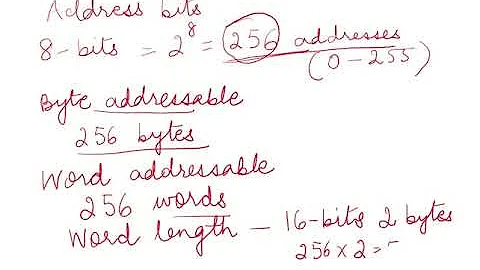How much bytes does an address take?
Solution 1
The sizes of the built-in types (char, short, int, long) are implementation specific and platform specific. If we assume your int is 32 bits, then we can address some of your questions:
If i resides at 0xdeadbeef, then 0xdeadbeef, 0xdeadbef0, 0xdeadbef1, and 0xdeadbef2 byte addresses would all be used to store i. If you were to set iPtr to 0xdeadbeee and write a value, 0xdeadbeee and the following three addresses would then contain the value you wrote. If you then attempt to read c or i, you would find the value corrupted.
Some things to consider: not all architectures allow byte addressing. A char may be one byte on your system, but due to limitations, 4 bytes may be reserved. Likewise, you may not be able to read or write a pointer that points to non-aligned addresses. For example, a system that can only access memory on 32 bit boundaries could only access 0xdeadbeec or 0xdeadbef0.
Solution 2
Yes, the address &i+1byte is an address of the second byte of i.
If you live on Memory Street 100 in 4 houses, you have four addresses. But those addresses address different buildings. Although, depending on your postal service the mail may not be delivered if it's not the canonical address (the same goes for memory access — depends on the platform).
Solution 3
How could you find this out? How about:
printf("%zu\n", sizeof(iPtr));
But, as @H2CO3 points out, you're really asking about pointer arithmetic. Read up more on that for more info.
Solution 4
You can find out how many bytes a pointer takes by using sizeof:
size_t int_ptr_size = sizeof(int*);
If you try to access data through a pointer that isn't properly aligned for the type, you invoke undefined behavior, so it's unpredictable what will happen. On some architectures, the program will crash with a Bus Error.
Related videos on Youtube
Comments
-
Davlog about 2 years
Basically my question is how much bytes does a single address take / have?
I mean a
chartakes 1 byte on my platform and has 1 address. But aninttakes 4 bytes. How many addresses does thisinttake? Does it still have only 1 address or does it have 4?For example :
char c = 'A'; //Address at 0xdeadbeee int i = 45846; //Address at 0xdeadbeef int* iPtr = &i; iPtr++; //Address at 0xdeadbef3 nowWhat happens with the addresses between
0xdeadbeefand0xdeadbef3? Are they all reserved fori? What happens to i when I point to0xdeadbeee(should be exactly one address | byte or whatever underi) and change it's value?Edit: for those who will still answer, I don't want to know how big an integer is. I want to know if it has also 4 addresses when taking 4 bytes of memory and what happens (if it has 4 addresses) when changing one of these addresses' value.
I hope it's clearer now.
-
fvdalcin over 10 yearsAnd on most processors (does anyone have a counter example?), the memory is byte oriented, i.e. each byte has an unique address. So, literally speaking, an
intdoes have 4 addresses.
-
-
Michael Krelin - hacker over 10 yearsAlthough this is a correct answer to the question
how many bytes does the address have, further prose suggests that it's not what the OP really wanted to ask. -
Davlog over 10 years@ChristianTernus If I'm not wrong I get the size of iPtr which is 8 bytes on my platform. I already know the sizes. My question was if it has as many addresses as bytes.








